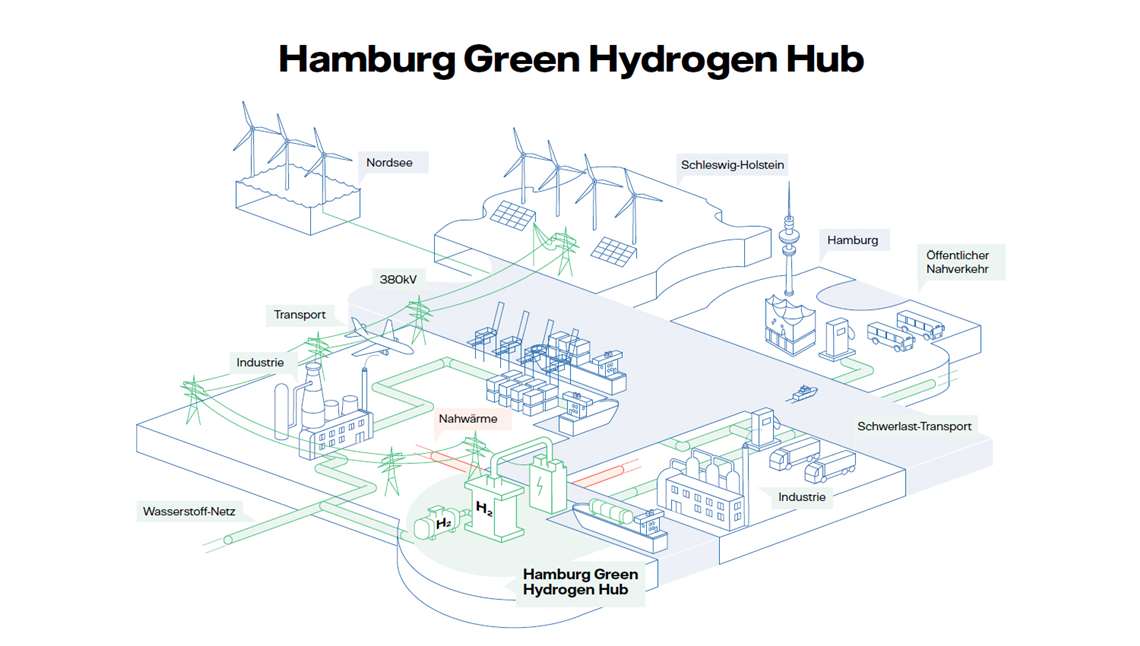Hydrogen production planned for port of Hamburg
22 January 2021
Shell, MHI among partners in project
A major hydrogen production facility is being planned for the port of Hamburg, Germany.
The companies Vattenfall, Shell, Mitsubishi Heavy Industries (MHI) and Hamburg’s municipal heat supplier Hamburg Wärme are planning to build one of the world’s largest electrolyzers—with a capacity of 100 MW—on the site of the former Moorburg coal-fired power plant.
Germany has plans to invest €9 billion in the development of a green hydrogen economy. Forecasts predict that the hydrogen economy in Europe will generate 5.4 million jobs and €800 billion in annual sales by 2050. The companies Shell, Mitsubishi Heavy Industries (MHI), Vattenfall and municipal company Wärme Hamburg are planning how they can jointly produce hydrogen from wind and solar power at the Hamburg-Moorburg power plant site and utilize it in its vicinity.

In addition to the construction of a scalable electrolyzer with an initial output of 100 MW, the further development of the site into a so-called “Green Energy Hub” is planned. This includes the exploration of the extent to which the existing infrastructure of the Moorburg location can be used for the production of energy from renewable sources. In this context, concepts for the necessary logistics chains and storage options for hydrogen will also be considered. Subject to final investment decision and according to the current state of planning, once the site has been cleared, the production of green hydrogen is anticipated in the course of 2025, the companies said.
“The establishment of a green hydrogen hub that is fully integrated into Hamburg’s industrial infrastructure would show Europe and the world that the hydrogen economy is real and can make a significant contribution to the decarbonization of the energy system and heavy industry,” said Kentaro Hosomi, president and CEO Energy Systems, Mitsubishi Heavy Industries.
The partners intend to apply for funding under the EU program Important Projects of Common European Interest (IPCEI). This should take place in the first quarter of 2021 with the submission of a first outline of the project. The four partner companies view the energy location as having ideal conditions for further use. It is connected to both the national 380 000 volt transmission network and the 110 000 volt network of the city of Hamburg. In addition, overseas ships can call at the location directly and use the quay and port facilities as an import terminal. The municipal gas network company also intends to expand a hydrogen network in the port within 10 years and is already working on the necessary distribution infrastructure. Numerous potential customers for green hydrogen are located near the site, thus enabling the project to cover the entire hydrogen value chain - from generation to storage, transport and utilization in various sectors. With these prerequisites, the Moorburg location is optimal for the German federal state of the Free and Hanseatic City of Hamburg and Northern Germany and can become a potential starting point for the development of a hydrogen economy.For many years, Moorburg was the site of a gas-fired power plant operated by Hamburgische Electricitäts-Werke, and Vattenfall had been operating a coal-fired power plant here since 2015. Its commercial operation was terminated after the power plant won a bid in the auction for the nationwide coal phase-out in December 2020. A decision by the transmission system operator on the system relevance of the plant is expected in March 2021. The City of Hamburg and Vattenfall are striving to clear [partial] areas of the site as soon as possible for the project to produce green hydrogen and the development of a Green Energy Hub.In their efforts to form a consortium, the four companies can also count on the support of the City of Hamburg’s government. In their coalition agreement, the governing parties agreed to examine and support the feasibility of sector coupling and the establishment of hydrogen production in the city-state.
“In the future, green hydrogen will play a very important role in the energy system and therefore also for us,” said Fabian Ziegler, CEO of Shell in Germany. “We keep an eye on the development of the entire value chain for hydrogen; from the entry into electricity production from offshore wind to the expansion of capacities for green hydrogen production as well as to the supply for mobility or transport applications and other industries. To achieve this, we need to and we want to collaborate with strong partners. We consider this project of the consortium of four together with the city of Hamburg to be exemplary.”
STAY CONNECTED




Receive the information you need when you need it through our world-leading magazines, newsletters and daily briefings.
POWER SOURCING GUIDE
The trusted reference and buyer’s guide for 83 years
The original “desktop search engine,” guiding nearly 10,000 users in more than 90 countries it is the primary reference for specifications and details on all the components that go into engine systems.
Visit Now
CONNECT WITH THE TEAM










